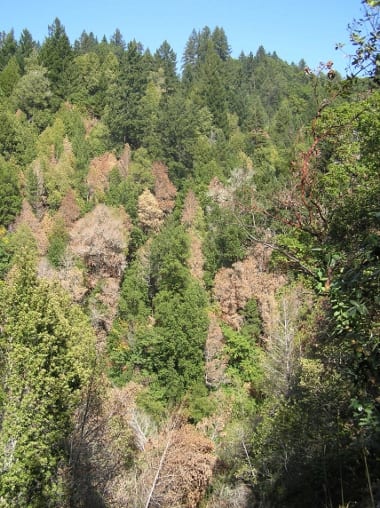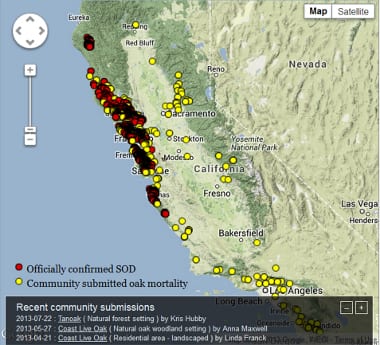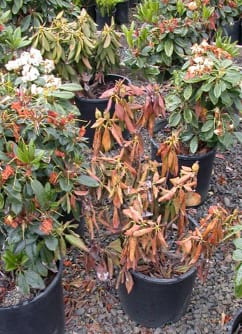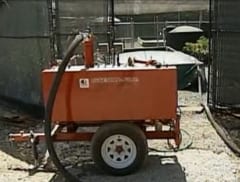by Janice Alexander
A plant disease commonly known as sudden oak death is killing trees in the coastal forests of western North America and portions of the United Kingdom and is an emerging threat in other areas. The disease is caused by the exotic, quarantine pathogen Phytophthora ramorum. While sudden oak death has killed a million tanoak and oak trees in California alone, numerous other species are susceptible to a non-fatal disease caused by the same pathogen. Called Ramorum blight, its hosts include many common garden plants. These plants serve as sources for inoculum that facilitate pathogen spread around the world. Nursery growers, landscapers, and homeowners across the country must therefore be aware of symptoms and management recommendations to reduce the spread of the pathogen.

Coastal California forest show evidence of many dying tanoaks. Photo by Susan Frankel, USDA Forest Service, Pacific Southwest Research Station.
Pathogen, hosts and symptoms
P. ramorum can be found in living, dying, or recently dead plants, and its spores can be found in soil, water, and infected plant material. As a water mold, the pathogen prefers moist environments and moderate temperatures. Infections are lethal to a small number of tree species, while a larger number of plants are susceptible to less severe leaf and twig infections which rarely cause mortality.
Detection and diagnosis
Early detection is key to keeping the disease in check. Other organisms and injuries can produce symptoms that look similar to a P. ramorum infection. Visual identification alone is inadequate – a lab test is required for absolute certainty. Below are some steps that can help you determine if P. ramorum is likely and whether to submit a sample for laboratory testing.
1) Determine if your plant is a known susceptible species. Check the most recent list of affected plants online, but note that this list is continually expanding.

Online maps show the current known distribution of the pathogen in California. Photo from www.oakmapper.org.
2) Determine if you are in an infested area. Check online maps or contact your state’s Department of Agriculture. If you are outside of an infested area, your plant could still be infected with P. ramorum, particularly if it was recently purchased from a nursery.
3) Compare the P. ramorum symptoms found online with those found on your plant. Check other known susceptible species nearby. Do they have leaf spots or other P. ramorum symptoms?
The probability that your plant is infected with P. ramorum will be greater if it is a known susceptible species, if it exhibits typical symptoms, and if it is located in an infested area where other trees and plants are showing symptoms. If you suspect a P. ramorum infection, contact your state’s Department of Agriculture for more information and assistance in collecting and submitting a sample for laboratory testing.

Rhododendrons infected with Phytophthora ramorums can be found at nurseries. Photo courtesy Jennifer Parke, Oregon State University.
Reducing spread
Despite the large host list, only a few species are thought to be high risk for spreading the pathogen. In the horticultural trade, these are rhododendron, camellia, pieris, and viburnum. Because of their potential for spread in wildland areas, California bay laurel and kalmia are also considered high risk. The pathogen is most active during wet periods, making the risk of spread greatest in muddy conditions and rainy weather. P. ramorum may also be transported to new areas when infested plants or soil are moved. State and federal regulations are in place to help stop this inadvertent spread. P. ramorum-susceptible plant species and materials are regulated nationally by the US Department of Agriculture, Animal and Plant Health Inspection Service (USDA APHIS). Information on restrictions and exceptions, as well as regulated plants, plant parts, and counties, can be found on the APHIS web site.
Landscape management
The listing of a species as a P. ramorum-regulated plant does not preclude it from a well-designed garden. However, it may be prudent to plant P. ramorum host plants up to five (5) meters away and downslope from any susceptible oaks. When making a purchase from a nursery, it is prudent to assess a plant’s overall health and check for any symptoms. After purchasing a host plant, you may also want to keep it in a holding area, away from other landscape plants, to allow any latent symptoms to express themselves

Demonstration of steam treatment for infested nursery soils at the NORS-DUC facility. Photo from KTVU TV.
When the pathogen is introduced to a new area, early action can eradicate it, especially in small, landscaped situations. In larger nurseries, eradication can be difficult, especially once the pathogen has infested soil and irrigation water. Research at the NORS-DUC facility is examining control methods for these situations, including steam-treating infested soil. For those homeowners and land managers in the wildland-urban interfaces of California and Oregon who are dealing with infected trees, further information on treatment options for oaks, proper disposal methods, and sanitation steps are available online. Wildland infestations have thus far proved immune to treatment efforts, which makes early detection and efforts to reduce human-mediated spread all the more important.
Resources
Symptoms photos, maps, and other diagnostic tools: www.suddenoakdeath.org
Host plants: www.aphis.usda.gov/plant_health/plant_pest_info/pram/downloads/pdf_files/usdaprlist.pdf
Distribution maps: http://www.suddenoakdeath.org/library/maps/
Best Management Practice guide for landscape professionals: http://www.suddenoakdeath.org/wp-content/uploads/2010/08/landscaper_1-08.pdf
USDA APHIS: http://www.aphis.usda.gov/plant_health/plant_pest_info/pram/index.shtml
State Departments of Agriculture: http://www.rma.usda.gov/other/stateag.html
NORS-DUC research facility: http://www.dominican.edu/academics/hns/sciencemath/community-partnerships-and-initiatives/norsduc
About the Author
Janice Alexander is the sudden oak death outreach coordinator for the University of California Cooperative Extension, Marin County, and the California Oak Mortality Task Force. For the past 11 years, she has overseen statewide outreach efforts, including maintaining the suddenoakdeath.org website, hosting workshops, and writing articles. Her education has focused on plant ecology and invasive species and she holds a B.A. in Environmental Science and an M.S. in Range Management, both from the University of California, Berkeley. Janice may be reached at jalexander@ucanr.edu.

